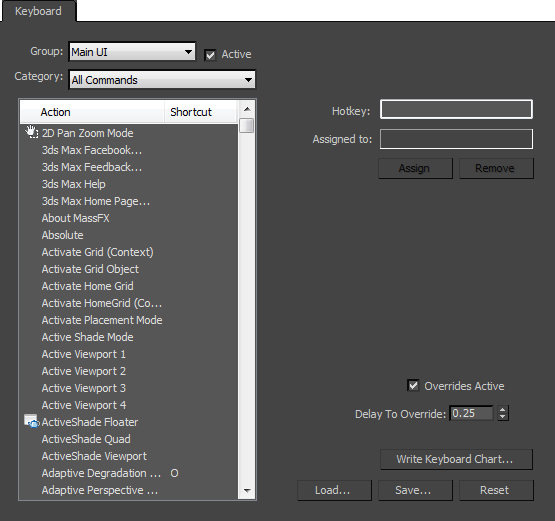The Keyboard panel lets you create your own keyboard shortcuts. You can assign shortcuts to most commands available in 3ds Max.
The same shortcuts can be assigned to multiple commands, as long as they occur in different contexts. For example, in Video Post, the shortcut  +S is assigned to Add Scene Event; however, in the Main UI, it is assigned to Save File.
+S is assigned to Add Scene Event; however, in the Main UI, it is assigned to Save File.
When you use a keyboard shortcut, 3ds Max looks for a context-specific shortcut first. If none is found it then looks for the appropriate command in the Main UI shortcuts.
For the context-specific shortcuts to work properly, the Keyboard Shortcut Override toggle must be on (the default). If it is off, only the Main UI keyboard shortcuts are available.
Customized mouse settings use the KBDX file format. The default settings are saved in defaultui.kbdx. (Prior to 3ds Max 2013, keyboard files had a file name extension of KBD. This format is now superseded.)
When you choose Maya as the interaction mode, the shortcut settings are updated to behave in a manner compatible with Autodesk Maya. These settings are saved in defaultui.kbdx. These settings are saved in mayamodeui.kbdx, and choosing Maya mode copies them to defaultui.kbdx. Conversely, choosing 3ds Max mode copies the settings from maxmodeui.kbdx to defaultui.kbdx.
The first time you start 3ds Max on your system, 3ds Max generates maxmodeui.kbdx based on the settings in the defaultui.kbdx file that ships with 3ds Max.
Procedures
To create a keyboard shortcut:
- Choose Customize menu
 Customize User Interface
Customize User Interface  Keyboard panel.
Keyboard panel. - Use the Group and Category lists to find the action for which you want to create a shortcut.
- Click action in the Action list to highlight it.
- In the Hotkey field, enter the keyboard shortcut you want to assign to the action. Note: If the keyboard shortcut you enter is already assigned to an action, that action name appears in the Assigned To field.
- Click Assign.
Interface

- Group drop-down list
- Lets you select the context you want to customize, such as Main UI, Track View, Material Editor, and so on.
- Active
- Toggles availability of context-specific keyboard shortcuts. When on, you can use duplicate shortcut keys between contexts within the overall user interface. For example, A can be the shortcut for Angle Snap toggle within the Main UI, and also a shortcut for Assign Material to Selection when you are working in the Material Editor. When Active is off, the shortcuts defined for the appropriate context are not available. Default=on.
- Category drop-down list
- Lets you choose among categories of user interface actions for the chosen group.
- Action list
- Displays all the available actions and shortcuts, if defined, for the chosen group (context) and category.
- Hotkey field
- Lets you enter a keyboard shortcut. Once the shortcut is entered, the Assign Button is active.
- Assigned To
- Displays the action a shortcut is assigned to if the shortcut you entered is already assigned.
- Assign
- Becomes available when you enter a keyboard shortcut in the Hotkey field. When you click Assign, it transfers the shortcut information to the Action list on the left side of the dialog.
- Remove
- Removes all shortcuts for the selected action in the Action list on the left side of the dialog.
- Overrides Active
- When on, holding keys for boldface shortcuts in the Edit Poly and Editable Poly groups overrides standard functionality. For example, while editing an Editable Poly object at the Polygon sub-object level, pressing and holding
 +
+ +B activates the Bevel tool temporarily, overriding the current operation.
+B activates the Bevel tool temporarily, overriding the current operation. - Delay To Override
- The delay before which the active keyboard shortcut overrides the current operation (see Overrides Active, preceding).
- Write Keyboard Chart
- Opens the Save File As dialog, where you can save changes you made to keyboard shortcuts in a TXT file that you can print.
- Load
- Displays the Load Shortcut File dialog. Allows you to load custom shortcuts from a KBDX file into your 3ds Max interface.
- Save
- Displays the Save Shortcut File As dialog. Allows you to save any changes you’ve made to the shortcuts to a KBDX file.
- Reset
- Restores the shortcuts to the default setup (defaultui.kbdx).